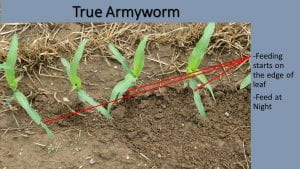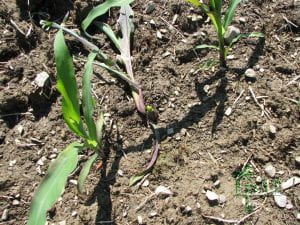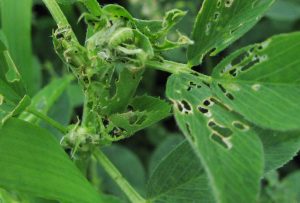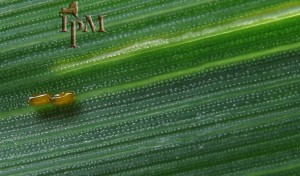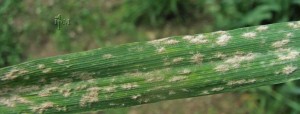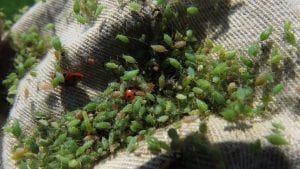Contents
Black cutworm and True armyworm
There have been a few intense catches for black cutworm and true armyworm with our field corn pheromone-trapping network in western NY. The flight for both black cutworm and true armyworm in Seneca County (Seneca Falls) has hatched. You might see leaf-feeding for black cutworm but most likely no cutting yet. For true armyworms, the typical symptoms are feeding on the edge of the leaf and working their way to the midrib. The black cutworm flight in Monroe County (Rush) is laying eggs. For management information on both insect pests, please view the following page.
Black Cutworm
https://cals.cornell.edu/field-crops/corn/insects-corn/cutworms
True Armyworm
https://cals.cornell.edu/field-crops/corn/insects-corn/armyworms
2022 Interactive Pheromone Trapping Network Map on Black Cutworm and True Armyworm Flights
Black Cutworm Degree Day Accumulations from March 1 to May 16
| *Location for Intense Catches |
Black Cutworm (Base 50) |
Life Stage |
|
Seneca Falls Seneca County April 26 25 Moths Caught |
136 |
Leaf Feeding 1st-3rd Instar |
|
Rush Monroe County May 15 39 Moths Caught |
30 |
Laying Eggs 1st-3rd Instar |
*Intense Catch is over 15 moths in a week.
True Armyworm Degree Day Accumulations from March 1 to May 16
| *Location for Intense Catches |
True Armyworm (Base 50) |
Life Stage |
|
Seneca Falls Seneca County April 26 29 Moths Caught |
136 |
Eggs Hatch |
*Intense Catch is over 15 moths in a week.
Alfalfa Weevil
Alfalfa weevil activity has increased this week. There are a few reports from the Western New York Crop Management Association that alfalfa weevil are over threshold in some fields. It is time to scout fields and determine if your alfalfa is over threshold.
For more on alfalfa weevil please view the link to management information:
https://cals.cornell.edu/field-crops/forages/insects-forage-crops/alfalfa-weevil
Alfalfa Weevil Degree Day Accumulations from March 1 to May 5
| Weather Station Location | Alfalfa Weevil | Life Stage |
| Arkport | 224 | Egg Laying |
| Bergan | 246 | Egg Laying |
| Ceres | 246 | Egg Laying |
| Corwin | 219 | Egg Laying |
| Gansevoort | 263 | Egg Laying |
| Geneva | 268 | Egg Laying |
| Highland | 328 | Larvae Feeding |
| Ithaca | 293 | Hatching |
| Kinderhook | 266 | Egg Laying |
| Laurens | 284 | Egg Laying |
| Malone | 179 | Egg Laying |
| Northport | 321 | Larvae Feeding |
| Peru | 175 | Egg Laying |
| Red Hook | 287 | Egg Laying |
| Versailles | 287 | Larvae Feeding |
| Watertown | 196 | Egg Laying |
Alfalfa Weevil Life stage Development
Growing Degree Days for peak (50%) occurrence of stage
| Stage of Life Cycle | Degree Days * |
| eggs hatch | 280 |
| Instar 1 | 315 |
| Instar 2 | 395 |
| Instar 3 | 470 |
| Instar 4 | 550 |
| Cocooning | 600 |
| Pupa | 725 |
| Adult Emergence | 815 |
*48 degree F base temperature
Cereal Leaf Beetle
There are more reports of cereal leaf beetle adults on small grains. There have been no eggs or larvae reported yet.
https://cals.cornell.edu/field-crops/small-grains/insects-small-grains
Powdery Mildew
There are a few reports that some fields of small grains have powdery mildew. This disease can really limit yield if it reaches high infestation rates. Please view the following page for more information.
https://cals.cornell.edu/field-crops/small-grains/diseases-small-grains/foliar-diseases
Pea Aphids
Pea aphids have been found in alfalfa fields. Pea aphids generally do not cause yield losses due to the fact NYS has many natural enemies that control them. In recent years, we have had some fields that reach an economic threshold for this pest. For more information on pea aphids please view the following page:
https://extension.entm.purdue.edu/fieldcropsipm/insects/pea-aphid.php


